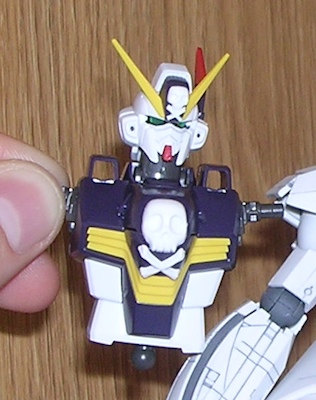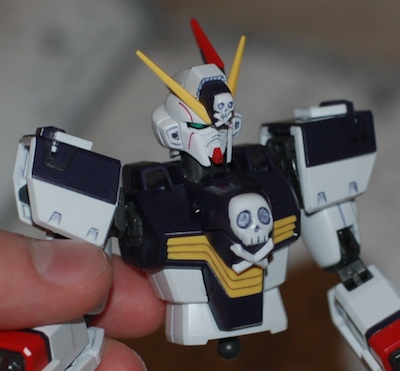Line detailing is the simple process of painting or otherwise coloring the detail lines that criss cross your Gunpla. This process can be very easy to very difficult depending how you want to go about things. Regardless, in the end your kit will go from…


 Paint Prep
Paint Prep
If you’re going to use paint, you need to a bit of prep first. No matter which paint you’re going to use for this application you need to mix it with thinner until it achieves a watery consistency and can run smoothly. This will allow the paint to run along the lines, and if you’re fortunate, save yourself a lot of work. If you’re working on a kit that’s been painted with flat paints it’s very important to cover the piece in a good gloss coat. This helps smooth out the surface to allow the paint to flow freely again. Even if you didn’t use a flat paint it’s a good idea as it will help protect the paint below. Most importantly, use a different type of top coat than the paint below and the kind you’re using for the detail lines. If you don’t the thinner in the line mixture will eat away the paint below.
 And so we begin…
And so we begin…
Regardless of what you’re using to line, pencil, Gundam Markers, or paint, the process is the same. Select the right color – While some people decide to do all of their lines in solid black which popular opinion states it looks like shit and should be avoided. (To be fair it can be done right but many people just apply way to much). Personally, I try to do a slightly darker version of the [plastic] color in most instances. For example I tend to do light gray on white, a medium gray on mid colors such as light blue, and black on darker colors such as navy blue. If you’re mixing paints be sure to throw in a few parts of the color you’re lining over for added detail (when I lined a red Zaku with paint I did a mixture of red and black). What color you use should be up to your own personal preference. Don’t be afraid to try out non traditional colors as well! Carefully apply into the parts – This can be the difficult part, especially for those who are lazy or have a nervous twitch. Using a marker or pencil is pretty straight forward. When using paint make sure it’s thinned out well as that will cause the paint to seep along the crevices. Use as fine a brush as possible because at times it may not work so well. The more careful you perform this, and the less excess needs to be cleaned up, the smoother the last step will go. Clean up excess – Paper towels, sand paper, and an eraser are your primary tools here. Depending on what you used paper towels can help clean up your paint and marker as it’s still wet. Try to brush lightly and avoid smudging the paint around all over the place. After it’s begun to dry an eraser will work well in most instances and so will a light brush with a fine grit sandpaper. Some Gundam Markers kits come with an eraser pen specially designed to help remove excess. The fine tip is great for hard to reach places. Those using paint can also use a bit of thinner applied to a paper towel or cotton swab. Unfortunately this can lead to big trouble…

If thinner seeps into the many cracks and crevices it can and will cause your pieces to crack and sometimes break off completely. Use in moderation and with caution. I’ve only seen (and had this happen to myself) with enamel paints & enamel thinner. While I can’t comment on acrylic and lacquer thinner I can only assume the same and suggestion caution none the less.


